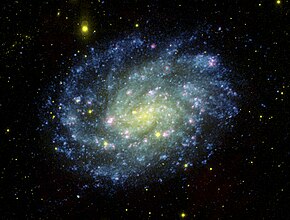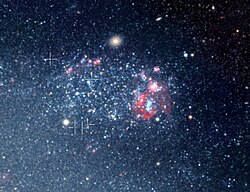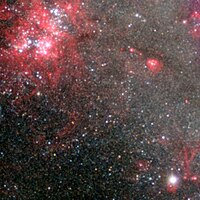NGC 300
| NGC 300 | |
|---|---|
 | |
| Pozorovací údaje (Ekvinokcium J2000,0) | |
| Typ | spirální galaxie SA(s)d[1] |
| Objevitel | James Dunlop[2] |
| Datum objevu | 1826[2] |
| Rektascenze | 00h 54m 53,5s[1] |
| Deklinace | -37°41′04″[1] |
| Souhvězdí | Sochař |
| Zdánlivá magnituda (V) | 8,3[2] |
| Úhlová velikost | 21,9' x 15,5'[1] |
| Vzdálenost | 6,40 ± 0,90 Mly (1,96 ± 0,28 Mpc)[1] |
| Plošná jasnost | 14,5[2] |
| Poziční úhel | 111°[2] |
| Rudý posuv | 114 km/s[1] |
| Označení v katalozích | |
| New General Catalogue | NGC 300 |
| IRAS | IRAS 00525-3757 |
| Principal Galaxies Catalogue | PGC 3238 |
| Jiná označení | NGC 300, PGC 3238,[1] Caldwell 70 |
| (V) – měření provedena ve viditelném světle | |
| Některá data mohou pocházet z datové položky. | |
NGC 300 (také známá jako Caldwell 70) je spirální galaxie v souhvězdí Sochaře vzdálená přibližně 6,4 milionů světelných let. Objevil ji australský astronom James Dunlop v roce 1826. Při pohledu ze Země je nakloněná pod úhlem 42° a v mnoha vlastnostech se podobá Galaxii v Trojúhelníku.[3]
Pozorování

Na obloze se nachází v jižní části souhvězdí Sochaře u hranice se souhvězdím Fénixe, 12 stupňů jižně od Galaxie Sochař. Ve střední Evropě nevychází vysoko nad obzor. 8 stupňů západně leží galaxie NGC 55.
Sousední galaxie
NGC 300 je jednou z pěti nejjasnějších spirálních galaxií ve směru skupiny galaxií v Sochaři.[4] Spolu se spirální galaxií NGC 55 bývá běžně označována za součást skupiny galaxií v Sochaři, která se nachází ve stejnojmenném souhvězdí a sousedí s Místní skupinou galaxií. Ovšem nedávné měření jejich vzdálenosti ukazuje, že se tyto dvě galaxie nachází mezi těmito dvěma skupinami galaxií.[5] NGC 300 a NGC 55 spolu možná tvoří gravitačně vázanou dvojici.[6]
Záblesk NGC 300-OT
Na snímku z CCD, který 14. května 2008 pořídil amatérský astronom L. A. G. Berto Monard, objevil jeho autor zajímavý jasný záblesk, který dostal označení NGC 300-OT.[7] Nachází se na souřadnicích RA: 00h 54m 34.552s a DEC: −37°38′31.79″[8] ve spirálním rameni s probíhající tvorbou hvězd. Širokopásmová magnituda záblesku na tomto snímku byla 14,3. Předchozí snímek z 24. dubna 2008, pořízený těsně po vynoření NGC 300 zpoza Slunce, prokázal již započaté zjasnění s magnitudou přibližně 16,3. Na snímku z 8. února 2008, ani na předešlých, nebylo zjasnění pozorováno. Záblesk dosáhl svého maxima 15. května 2008 s naměřenou magnitudou 14,69.[9]
V době objevu měl záblesk absolutní magnitudu MV přibližně -13, což je málo v porovnání s běžnou supernovou se zhrouceným jádrem, ale více než obyčejná nova.[7][9] Z fotometrických a spektroskopických vlastností navíc vyplývá, že nejde ani o jasnou modrou proměnnou hvězdu. Od jejího maxima jasnost plynule klesala až do září 2008 a spektrum červenalo. Po září 2008 již jasnost klesala pomaleji, ale obsahovala silné záření H-alfa.[9] Viditelné spektrum se dále skládá z poměrně úzkých emisních čar Balmerovy série vodíku, vápníku CA II spolu se silnou absorpcí Ca II H&K. Zkoumání starších snímků HST poskytlo přesnou horní hranici svítivosti původní hvězdy. To naznačovalo, že záblesk vytvořila původní hvězda hlavní posloupnosti s nízkou hmotností ve chvíli hvězdného sloučení podobného galaktické nově V838 Monocerotis.[7] Rozbor starších snímků z oblasti záblesku ukazuje s jistotou 70%, že původní hvězda vznikla před 8 až 13 miliony let a měla hmotnost 12 až 25 hmotností Slunce, a tedy předpokládá, že záblesk způsobila velmi hmotná hvězda během svého vývoje.[8]
V roce 2008 však byl v datech ze Spitzerova vesmírného dalekohledu objeven původce záblesku, který zářil v blízké infračervené oblasti. Tato prachem zakrytá hvězda měla výkonové spektrum záření podobné záření absolutně černého tělesa s parametry R ≈ 300 AU, T ≈ 300 K a zářivostí Lbol ≈ ×106 . To ukazuje na spojení záblesku s energetickým výbuchem hvězdy s malou hmotností (≈ 10 ). Malá zářivost záblesku proti typické supernově se zhrouceným jádrem spolu s jeho spektrálními vlastnostmi a zakrytím prachem jej činí téměř shodným se supernovou SN 2008S v galaxii NGC 6946.[7]
Spektrum záblesku NGC 300-OT pozorované Spitzerem vykazuje silné a široké spektrální čáry na vlnových délkách 8 μm a 12 μm. Tuto vlastnost můžeme najít i v galaktických protoplanetárních mlhovinách hvězd bohatých na uhlík.[7]
SN 2010da
23. května 2010 objevil Monard další záblesk 16. magnitudy, který dostal označení SN 2010da.[10] Viditelný záblesk byl objeven 15,9" západně a 16,8" severně od středu galaxie na souřadnicích 00h 55m 04.86s -37°41′43.7″.[11]
Dvě nezávislá následná spektroskopická pozorování naznačila, že spíše než o supernovu šlo opět o další jasný záblesk, možná vybuchující jasnou modrou proměnnou hvězdu,[12][13] jak bylo dříve předpovězeno z povahy možného blízce infračerveného původce.[14] Záblesk slábnul o 0,5 až 0,7 magnitudy za 9 dní, tedy mnohem rychleji než záblesk v roce 2008.[15]
Binární systém s černou dírou
Zdroj rentgenového záření v jádru NGC 300 se označuje NGC 300 X-1. Astronomové se domnívají, že NGC 300 X-1 je nový druh binárního systému Wolfovy–Rayetovy hvězdy s černou dírou podobný jinému takovému potvrzenému systému IC 10 X-1. Jejich společnými vlastnostmi jsou doba oběhu přibližně 30 minut a vyzařovaná energie přibližně 1×1038 erg.[16]
Galerie obrázků
Podrobný snímek NGC 300 z Hubbleova vesmírného dalekohledu.
Spirální galaxie NGC 300 na širokoúhlém snímku z observatoře La Silla v Chile. Autor: ESO.[17] Credits: ESO
Okolí NGC 300. Autor: ESO/Digitized Sky Survey 2
Cefeidy v NGC 300. Autor: ESO
NGC 300 X-1 ve spirální galaxii NGC 300.
Umělecká ilustrace dvojhvězdy s černou dírou na okraji NGC 300. Autor: ESO/L. Calçada
Toto video se přibližuje k místu obsahujícímu dvojhvězdu s černou dírou a končí uměleckým ztvárněním tohoto systému.
Video přibližování k NGC 300.
Reference
V tomto článku byl použit překlad textu z článku NGC 300 na anglické Wikipedii.
- ↑ a b c d e f g NASA/IPAC Extragalactic Database: Results for NGC 300 [online]. [cit. 2016-04-22]. Dostupné online. (anglicky)
- ↑ a b c d e The NGC/IC Project: Results for NGC 300 [online]. [cit. 2016-04-22]. Dostupné v archivu pořízeném dne 2009-05-28. (anglicky)
- ↑ Vlajić, M.; Bland-hawthorn, J.; Freeman, K.C. The Abundance Gradient in the Extremely Faint Outer Disk of NGC 300. S. 361–372. Astrophysical Journal [online]. Květen 2009 [cit. 2016-04-25]. Roč. 697, čís. 1, s. 361–372. Dostupné online. arXiv 0903.1855. DOI 10.1088/0004-637X/697/1/361. Bibcode 2009ApJ...697..361V. (anglicky)
- ↑ Rizzi, L.; Bresolin, F.; Kudritzki, R.-P., et al. The Araucaria Project: The Distance to NGC 300 from the Red Giant Branch Tip Using HST ACS Imaging. S. 766–771. Astrophysical Journal [online]. Únor 2006 [cit. 2016-04-25]. Roč. 638, čís. 2, s. 766–771. Dostupné online. arXiv astro-ph/0510298. DOI 10.1086/498705. Bibcode 2006ApJ...638..766R. (anglicky)
- ↑ KARACHENTSEV, I. D.; GREBEL, E. K.; SHARINA, M. E., et al. Distances to nearby galaxies in Sculptor. S. 93–111. Astronomy and Astrophysics [online]. Červen 2003 [cit. 2016-04-25]. Roč. 404, čís. 1, s. 93–111. Dostupné online. arXiv astro-ph/0302045. DOI 10.1051/0004-6361:20030170. Bibcode 2003A&A...404...93K. (anglicky)
- ↑ VAN DE STEENE, G.C.; JACOBY, G.H.; PRAET, C., et al. Distance determination to NGC 55 from the planetary nebula luminosity function. S. 891–896. Astronomy and Astrophysics [online]. Září 2006 [cit. 2016-04-25]. Roč. 455, čís. 3, s. 891–896. Dostupné online. DOI 10.1051/0004-6361:20053475. Bibcode 2006A&A...455..891V. (anglicky)
- ↑ a b c d e PRIETO, J.L.; SELLGREN, K.; THOMPSON, T.A., et al. A Spitzer/IRS Spectrum of the 2008 Luminous Transient in NGC 300: Connection to Proto-Planetary Nebulae. S. 1425. The Astrophysical Journal [online]. Listopad 2009 [cit. 2016-04-25]. Roč. 705, čís. 2, s. 1425. Dostupné online. arXiv 0907.0230. DOI 10.1088/0004-637X/705/2/1425. Bibcode 2009ApJ...705.1425P. (anglicky)
- ↑ a b Gogarten, S.M.; Dalcanton, J.J.; Murphy, J.W., et al. The NGC 300 Transient: An Alternative Method for Measuring Progenitor Masses. S. 300–310. Astrophysical Journal [online]. Září 2009 [cit. 2016-04-25]. Roč. 703, čís. 1, s. 300–310. Dostupné online. arXiv 0907.0710. DOI 10.1088/0004-637X/703/1/300. Bibcode 2009ApJ...703..300G. (anglicky)
- ↑ a b c Bond, H.E.; Bedin, L.R.; Bonanos, A.Z., et al. The 2008 Luminous Optical Transient in the Nearby Galaxy NGC 300. S. L154–L158. Astrophysical Journal Letters [online]. Březen 2009 [cit. 2016-04-25]. Roč. 695, čís. 2, s. L154–L158. Dostupné online. arXiv 0901.0198. DOI 10.1088/0004-637X/695/2/L154. Bibcode 2009ApJ...695L.154B. (anglicky)
- ↑ ATEL 2640: Optical Photometry of the New Optical Transient SN 2010da in NGC 300 [online]. Astronomers Telegram, 2010-05-26 [cit. 2016-04-25]. Dostupné online. (anglicky)
- ↑ List of Supernovae [online]. Harvard-Smithsonian Center for Astrophysics (IAU) [cit. 2016-04-25]. Dostupné online. (anglicky)
- ↑ ATEL 2636: SN 2010da is a SN impostor [online]. Astronomers Telegram, 2010-05-25 [cit. 2016-04-25]. Dostupné online. (anglicky)
- ↑ ATEL 2637: Spectroscopy of SN 2010da in NGC 300 [online]. Astronomers Telegram, 2010-05-25 [cit. 2016-04-25]. Dostupné online. (anglicky)
- ↑ ATEL 2632: Mid-IR progenitor of SN 2010da in NGC 300 [online]. Astronomers Telegram, 2010-05-24 [cit. 2016-04-25]. Dostupné online. (anglicky)
- ↑ ATEL 2660: Optical and Near-IR Follow-up of SN 2010da: Evidence for Warm Dust [online]. Astronomers Telegram, 2010-06-04 [cit. 2016-04-25]. Dostupné online. (anglicky)
- ↑ Barnard, R.; Clark, J.S.; Kolb, U.C. NGC 300 X-1 and IC 10 X-1: a new breed of black hole binary?. S. 697–703. Astronomy and Astrophysics [online]. Září 2008 [cit. 2016-04-25]. Roč. 488, čís. 2, s. 697–703. Dostupné online. arXiv 0807.0606. DOI 10.1051/0004-6361:20077975. Bibcode 2008A&A...488..697B. (anglicky)
- ↑ A Nearby Galactic Exemplar [online]. ESO Press Release, 2010-09-08 [cit. 2016-04-25]. Dostupné online. (anglicky)
Externí odkazy
 Obrázky, zvuky či videa k tématu NGC 300 na Wikimedia Commons
Obrázky, zvuky či videa k tématu NGC 300 na Wikimedia Commons - Simbad – NGC 300
- NED – NGC 300
- APOD (2005-08-20) The Stars of NGC 300
- APOD (2002-08-22) Shell Game in NGC 300
Média použitá na této stránce
Autor: ESO/Digitized Sky Survey 2/P. Crowther/L. Calçada, Licence: CC BY 4.0
Astronomers using ESO’s Very Large Telescope (VLT) have detected a stellar-mass black hole much further away than any other previously known. With a mass twenty times that of the Sun, this is also the second most massive stellar mass black hole ever found. The newly announced black hole lies in a spiral galaxy called NGC 300, six million light-years from Earth. This video zooms in onto the position of the system containing the stellar-mass black hole, and finishes with an artist’s impression of the system.
Autor: ESO, IAU and Sky & Telescope, Licence: CC BY 4.0
This chart shows the location of the NGC 300 galaxy within the constellation of Sculptor. This map shows most of the stars visible to the unaided eye under good conditions and the galaxy itself is marked as a red oval in a circle at the left (labelled 300 for NGC 300). This galaxy is fairly bright and is bright enough to be seen easily in binoculars.
Autor: ESO, Licence: CC BY 3.0
Some of the Cepheid type stars in the spiral galaxy NGC 300 (at the centre of the markers), as they were identified by Wolfgang Gieren and collaborators during the research programme for which the WFI images of NGC 300 were first obtained. In this area of NGC 300, there is also a huge cloud of ionized hydrogen (a "HII shell"). It measures about 2000 light-years in diameter, thus dwarfing even the enormous Tarantula Nebula in the LMC.
Autor: ESO/Digitized Sky Survey 2, Licence: CC BY 4.0
This wide field image, from the Digitized Sky Survey 2, shows the area around the spiral galaxy, NGC 300, six million light-years from Earth. The field of view is about 2.92x2.94 degrees.
Autor: ESO/P. Crowther, Licence: CC BY 4.0
Astronomers using ESO’s Very Large Telescope (VLT) have detected a stellar-mass black hole much further away than any other previously known. With a mass about twenty times that of the Sun, this is also the second most massive stellar-mass black hole ever found. The newly announced black hole lies in a spiral galaxy called NGC 300, six million light-years from Earth. This image obtained with the FORS2 instrument on the VLT is centred on the position of the black hole. The image covers a field of view of about 2x2 arcminutes, or about 4000 light-years at the distance of NGC 300. The image is based on data obtained through a wide B filter and two narrow-band filters centred on 500 nm and H-alpha.
Autor: ESO, Licence: CC BY 4.0
This picture of the spectacular southern spiral galaxy NGC 300 was taken using the Wide Field Imager (WFI) at ESO’s La Silla Observatory in Chile. It was assembled from many individual images through a large set of different filters over many observing nights, spanning several years. The main purpose of this extensive observational campaign was to get an unusually thorough census of the stars in the galaxy, counting both the number and varieties of stars and marking regions, or even individual stars, that warrant deeper and more focussed investigation. But such a rich data collection will also have many other uses for years to come. The images were mostly taken through filters that transmit red, green or blue light. These were supplemented by images through special filters that allow through only the light from ionised hydrogen or oxygen gas and highlight the glowing clouds in the galaxy’s spiral arms. The total exposure time amounted to around 50 hours.
NASA image of the NGC 300 galaxy, taken from the Hubble space telescope. Individual stars are discernible.
This color composite image of nearby NGC 300 combines the visible-light pictures from Carnegie Institution of Washington's 100-inch telescope at Las Campanas Observatory (colored red and yellow), with ultraviolet views from NASA's Galaxy Evolution Explorer. Galaxy Evolution Explorer detectors image far ultraviolet light (colored blue).
This composite image traces star formation in progress. Young hot blue stars dominate the outer spiral arms of the galaxy, while the older stars congregate in the nuclear regions which appear yellow-green. Gases heated by hot young stars and shocks due to winds from massive stars and supernova explosions appear in pink, as revealed by the visible-light image of the galaxy.
Located nearly 7 million light years away, NGC 300 is a member of a nearby group of galaxies known as the Sculptor Group. It is a spiral galaxy like our own Milky Way.Autor:
Video: ESO
This zoom sequence starts with a view of part of the faint southern constellation of Sculptor. At the centre we see the spiral galaxy NGC 300, lying about six million light-years from us. It is one of the closest and brightest normal spiral galaxies and an ideal laboratory for studying such objects in great detail. We finish the zoom with a close-up of NGC 300 in a very detailed image from the Wide Field Imager (WFI) at ESO’s La Silla Observatory in Chile.
- Music: The forgotten castle from Album Fairytale by zero-project (Licensed in [1])
Autor: ESO/L. Calçada/M.Kornmesser, Licence: CC BY 4.0
This artist’s impression depicts the newly discovered stellar-mass black hole in the spiral galaxy NGC 300. The black hole has a mass of about twenty times the mass of the Sun and is associated with a Wolf–Rayet star; a star that will become a black hole itself. Thanks to the observations performed with the FORS2 instrument mounted on ESO’s Very Large Telescope, astronomers have confirmed an earlier hunch that the black hole and the Wolf–Rayet star dance around each other in a diabolic waltz, with a period of about 32 hours. The astronomers also found that the black hole is stripping matter away from the star as they orbit each other. How such a tightly bound system has survived the tumultuous phases that preceded the formation of the black hole is still a mystery.

![Spirální galaxie NGC 300 na širokoúhlém snímku z observatoře La Silla v Chile. Autor: ESO.[17] Credits: ESO](http://upload.wikimedia.org/wikipedia/commons/thumb/4/4b/View_of_the_southern_spiral_NGC_300.jpg/200px-View_of_the_southern_spiral_NGC_300.jpg)













